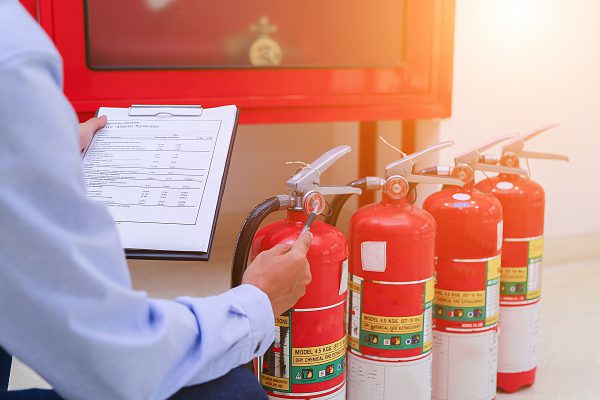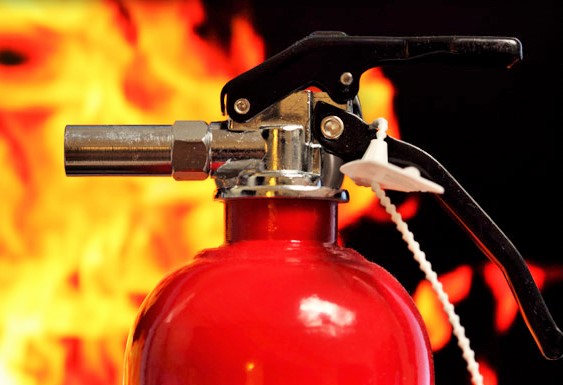-
May 30, 2018 by Total Fire and Safety

Most companies understand the mandate to have regular fire extinguisher inspections but many wonder why on earth a company could actually fail these inspections. After all, a fire extinguisher is rarely used so how can it need service?
Chances are you see a fire extinguisher every day, but how closely do you look at it? Even one dent in the tank can change the outcome. According to the NFPA, nearly 30 percent of fire extinguishers are not in proper working order. Total Fire and Safety’s twelve-point check can ensure your company’s compliance. However, there are five main reasons why companies fail a fire extinguisher inspection.
1. Unseen Damage– Corrosion or damage can occur over time in hard to see areas of the extinguisher, for example, rust within the tank. That is when a professional steps in and inspects the extinguisher inside and out. TFS will visually examine the extinguisher making sure it is free of dents, rust, or other hazards.
2. Potential Hose Blockage– Debris can clog the hose or deterioration of the O-rings can occur over time, rendering a fire extinguisher useless in an emergency. TFS will remove the hose completely to check for irregularities.
3. Possible Leaks– Whether large or small, a leak will cause the fire extinguisher to be inoperable. Anyone can check the pressure gauge to determine if there is a leak. However, if there is no pressure gauge, you will need a professional. TFS will confirm the compression in the tank.
4. Wear/Fading of Labels– Labels are vital when fighting a fire because they contain instructions on how to use the extinguisher. They also provide important information about the device’s maintenance history, which is needed by inspection professionals. Once your fire extinguisher inspection is complete, the labels will be updated, and an additional certification tag will be attached.
5. Recharging Needed– Once a fire extinguisher is used, even partially, it will need to be recharged immediately. If you fail to recharge the extinguisher, it will fail you in a fire.
Although these are common reasons companies fail fire extinguisher inspections, there are other possible hazards not listed. It is important to stay up-to-date with your fire extinguisher inspections. The NFPA requires inspection every month and maintenance every year by a professional. In addition, a stored pressure extinguisher requires internal maintenance every six years and a hydrostatic test every 12 years.
It takes a minute for a fire to spread and cause irreparable damage to your company—the same amount of time it takes to schedule a fire extinguisher inspection!
Total Fire and Safety can inspect your fire extinguishers to ensure they are unfailingly ready to fight fire at a moment’s notice. We also provide onsite training for your employees, including hands-on practice in the use of a fire extinguisher. Give us a call today at 630.960.5060.
Category: Business Safety, Fire code violation, Fire Equipment Inspections, Fire Extinguishers, Fire Extinguishers, Fire Safety, NFPA Compliance, Total Fire and Safety Tags: equipment, Extinguisher, fire and safety equipment, fire and safety needs, Fire Extinguisher, fire extinguisher inspections, fire safety, safety, Total Fire & Safety, Total Fire and Safety | Comments Off on Why Companies Fail Fire Extinguisher Inspections
-
January 15, 2018 by Total Fire and Safety

There’s no better way to ring in the new year and make sure your business is ready for any emergency 2018 brings than with proper fire extinguisher service at all of your locations. The National Fire Protection Association (NFPA) states that all portable fire extinguishers be inspected on a monthly basis and maintained by a licensed fire protection company on an annual basis. Yet each year nearly 25,000 fires cost companies over billions of dollars from not only recovery of property and premises but worker’s compensation filings and lawsuits from employees. Sometimes damages could have been reduced if employees had been aware of and actually used the fire extinguishers available.
Properly working fire extinguishers are a first line of defense against fires and can significantly minimize damage until help can arrive. Total Fire and Safety provides a thorough inspection that begins when we walk in the door, and continues throughout the building. Our fire extinguisher service contains our twelve-point check. What are the 12 points?
- Visual examination: We ensure the device is free of dents, rust, corrosion, and other related hazards.
- Test/Maintenance history: We review the test/maintenance history to ensure the internal system is active.
- Pressure Gauge: We check the pressure gauge to confirm the compression in the tank.
- Weight: We make sure the right amount of fluid is inside the tank.
- Discharge hose: We remove it and inspect for irregularities.
- Locking pin: We check for ease of removal in the event of a disaster.
- Handle/Lever: We ensure that the handle/pin will discharge smoothly.
- Clean Extinguisher: We degrease any pertinent areas.
- Inspection certification: We attach a safety flag and service tag to signify when service was completed.
- Extinguisher: We return it to the designated location.
- Mounting Bracket: We secure the extinguisher on its mount correctly.
- Hazard Application: We confirm you have the proper extinguisher type installed for your application.
Hand in hand with having extinguishers is teaching your employees how to use them. That’s why Total Fire & Safety also offers training courses for your employees/tenants so that in the case of an actual emergency, they will not hesitate to reach for the fire extinguisher.
Fire extinguishers are not only legally required but also give employees piece of mind, especially if they know how to use them. Employees appreciate working for a company that has their safety in mind. However, fire extinguisher service is definitely key.
If your fire extinguishers need service or are due for an inspection, please don’t hesitate to contact us at contact us at 630.960.5060.
Category: Fire Equipment Inspections, Fire Extinguishers, Fire Extinguishers, Fire Safety Tags: commercial fire safety, Extinguisher, fire and safety equipment, fire equipment inspection, Fire Extinguisher, fire extinguisher inspection, fire safety, fireextinguisher, Fireextinguishertraining | Comments Off on Is it time for Fire Extinguisher Service?
-
January 15, 2016 by Total Fire and Safety
Not only are fire extinguishers an important part of our everyday safety, but they are a part of our history as well. Have you ever wondered how this device became the little red powerhouses that keep our home and workplaces safe? Here are the highlights of fire extinguisher development throughout history.
- 200 BC- Ctesibius of Alexandria fashions a hand pump designed to deliver water to fires. It replaced the cumbersome technique of passing buckets from hand-to-hand to transport water to fire.
- The Middle Ages– Devices called ‘squirts’ were developed which worked like bicycle p
 umps. These were used on the 1666 Great Fire of London. umps. These were used on the 1666 Great Fire of London.
- 1819- Captain George Manby invents the first version of the modern portable fire extinguisher. It consisted of a copper vessel which sprayed a potassium carbonate solution using compressed air.
- 1912– An extinguisher model using carbon tetrachloride is mass-produced. It was suitable for liquid and electrical fires and was popular in motor vehicles for decades. However, the ingredients in this extinguisher were highly toxic, and some deaths did result in its use, particularly in small spaces.
- Mid-twentieth century– The modern fire extinguisher emerges, followed by various models using different ingredients. They generally use some kind of pressurized vessel to store and discharge the extinguishing agent.
Fire extinguishers have come a long way and remain our best defense against fire. It is important that everyone understand how to operate a fire extinguisher and to have proper fire extinguisher inspections. Fire extinguishers are required in commercial buildings, and it is also important to be up to code with your fire prevention. If you have questions about your building’s fire extinguisher requirements or would like more information about fire extinguishers, contact Total Fire and Safety at 630-960-5060.
Category: Fire Extinguishers, Fire Extinguishers, Total Fire and Safety Tags: Extinguisher, Fire Extinguisher, fire extinguisher history, firefighter history, history | Comments Off on Who Invented Fire Extinguishers?
-
August 18, 2015 by Total Fire and Safety
 1. There are different types of extinguishers for different fires. Make sure the fire extinguisher types in your building are the right type for the kind of fire that may happen, depending on the materials present in your business. 1. There are different types of extinguishers for different fires. Make sure the fire extinguisher types in your building are the right type for the kind of fire that may happen, depending on the materials present in your business.
2. To use a fire extinguisher, remember PASS. This acronym will walk you through the steps of using a fire extinguisher:
– Pull the pin. Hold the extinguisher with the nozzle
pointing away from you, and release the locking
mechanism.
– Aim low. Point the extinguisher at the base of the fire.
– Squeeze the lever slowly and evenly.
– Sweep the nozzle from side-to-side.
3. Fire extinguishers must be inspected by a licensed fire protection company on a monthly basis. This is an NFPA requirement. Total Fire and Safety has a 12-point fire extinguisher check that thoroughly assesses each portable fire extinguisher unit.
4. Fire extinguishers should be installed near exits. This will allow you to stay safely near an exit when using the extinguisher. If you do use it, keep a clear path to the exit and face your back to that exit. Evacuating all personnel is always the priority if a fire breaks out, so make sure you and everyone with you is within safe distance of an exit before attempting to extinguish the fire.
5. Employee training services are available. Total Fire & Safety has comprehensive training courses on many safety topics and fire equipment, such as CPR, machine safeguarding, emergency preparedness, and many others. They offer OSHA and AHA compliance courses in these topics also.
For more information about fire extinguishers in businesses, you can contact Total Fire and Safety at 630-960-5060.
Category: Fire Extinguishers, Fire Extinguishers, Fire Safety, Total Fire and Safety Tags: business, employee training, Extinguisher, Fire Extinguisher, fire extinguishers, fire safety, fire safety tips, safety training | Comments Off on 5 Things Businesses Should Know About Fire Extinguishers
-
March 12, 2013 by admin
Using state of the art technology, our Total Fire & Safety service team uses custom built reports that include voice data, photos, and apply all AHJ and state applicable codes. This ensures that your
company’s fire protection equipment has been tested properly.
Our service technicians go through extensive training in order to receive their state certifications. We hold regular in house safety meetings and continuous education programs to ensure that our technicians are always up to date on all the newest codes and standards.
In fact, our management team does regular onsite audits to ensure the job has been done correctly.
12-Point Portable Fire Extinguisher Service Check:
- Visual Examination: performed on the entire unit, carefully inspecting for dents, rust, corrosion, pitting or other shell damage
- Test/Maintenance History: reviewed to determine the need for required internal maintenance or hydrostatic testing
- Pressure Gauge: checked to ensure that the unit is fully pressurized
- Weight: the extinguisher is checked to ensure the correct amount of extinguishing agent is in cylinder
- Discharge Hose: removed to inspect for signs of blockage or damage
- Locking Pin: removed to ensure that the pin is easily removed in the event of an actual fire emergency
- Handle/Lever: checked for smooth discharge operation
- Clean Extinguisher: using a degreasing solution
- Inspection Certification: documented by attaching a safety flag and service tag indicating the work performed
- Extinguisher: returned to the proper location
- Mounting Bracket: checked to ensure extinguisher is installed securely on correct mounting hook or bracket
- Hazard Application: reviewed to make sure that the fire extinguisher is the correct type for a potential fire hazard
Category: Fire Extinguishers, Fire Safety Tags: businesssafety, equipment, Extinguisher, fire, Fire Extinguisher, fireextinguisher, safety, technology, training | Comments (1)
|

|
|
|
|
|
|

 Facebook
Facebook
 Instagram
Instagram
 LinkedIn
LinkedIn



